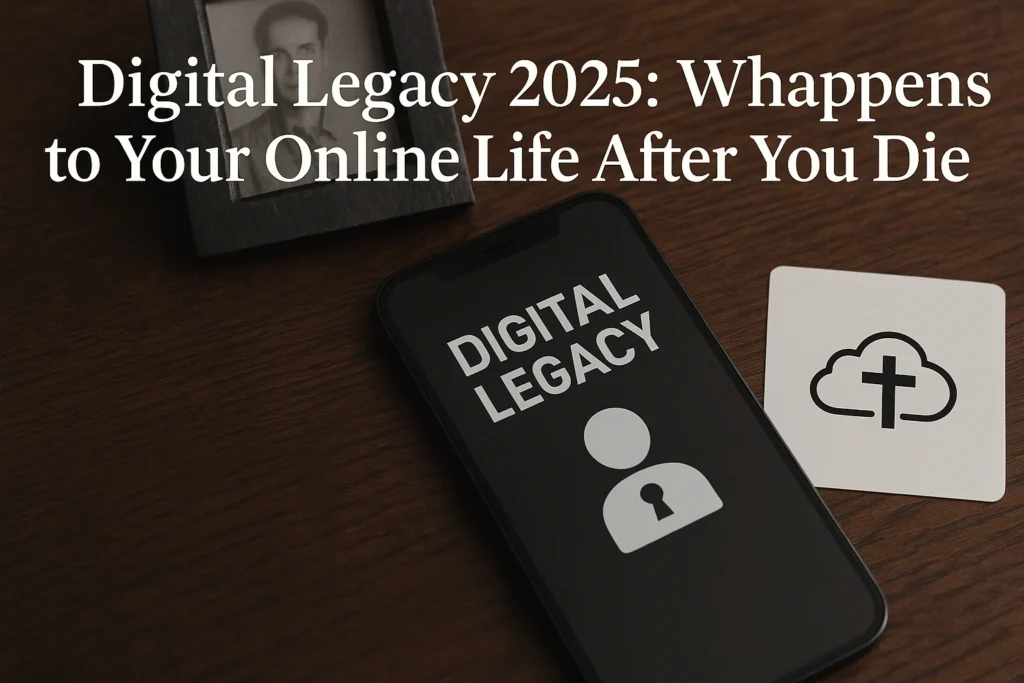Introduction: Your Digital Ghost in the Machine
For most of history, when someone passed away, their story lived on in physical photographs, handwritten letters, and the memories of loved ones. But in 2025, our lives are deeply intertwined with the digital world. Our social media profiles, endless cloud photos, personal emails, and even online gaming avatars form a sprawling “digital footprint” – a virtual echo of who we are. This raises a crucial question: What happens to this online life after we die?
As more people embrace the internet as a central part of their existence, a growing global interest in digital afterlife planning is emerging. It’s no longer just a morbid curiosity; it’s a practical and emotional necessity. From grieving families trying to access treasured photos to complex legal battles over virtual assets, the challenge of managing our digital selves after death is reshaping how we grieve, remember, and understand our own mortality in the modern age.
Taking Control: The Rise of Digital Afterlife Planning
Just as we plan for our physical assets with traditional wills, in 2025, more and more people are actively planning for their digital lives. This involves setting up specific instructions for what happens to their online accounts and data after they are gone.
Tools and Services for Your Digital Farewell
- Google’s Inactive Account Manager: A pioneer in this space, Google allows users to designate what happens to their accounts (Gmail, Google Drive, YouTube, etc.) if they become inactive for a set period (e.g., 3, 6, 12 months). You can choose to have your data deleted entirely, or you can grant trusted contacts access to specific data after a notification period. It’s a proactive step many are taking to manage their personal information.
- Meta’s Memorialization Settings: Platforms like Facebook and Instagram, owned by Meta, offer memorialization settings. Users can designate a “Legacy Contact” for their Facebook account. This person can manage the memorialized profile – responding to new friend requests, posting a final message, or arranging for the account to be deleted – but cannot log in as the deceased user or view their private messages. Instagram also offers similar options, allowing an account to be memorialized or removed.
- Digital Will Platforms: Beyond the big tech companies, a growing number of specialized digital will platforms and services have emerged. Companies like EverPlans, Trust & Will, and My Wonderful Life provide centralized platforms where you can securely store login credentials, instructions for social media accounts, cloud storage, email, and even cryptocurrency wallets. They often facilitate the transfer of this information to designated individuals upon verification of your death, acting as a digital executor.
These tools represent a critical step towards empowering individuals to exercise control over their digital identities, ensuring their online wishes are respected and that their digital legacy aligns with their real-world values.
The Legal Labyrinth: Who Owns Your Digital Footprint?
One of the thorniest aspects of digital legacy in 2025 is the complex legal and ethical challenge of who owns your digital footprint. Unlike physical property, digital assets exist in a murky legal area, often governed by the “Terms of Service” (TOS) agreements we click through without reading.
Data vs. Property
- The TOS Dilemma: When you sign up for a social media account or cloud storage, you typically agree to a TOS that states the platform owns the data you upload or grants them a license to use it. This means your family often doesn’t have an automatic right to access your accounts, even with a death certificate. They may only be able to memorialize or delete.
- Privacy vs. Access: There’s a constant tension between protecting the deceased person’s privacy and a grieving family’s desire to access cherished memories (like photos) or important information (like financial records stored in email). Laws are slowly evolving to address this, but it remains a complex issue.
- Evolving Legislation: Some regions are beginning to pass laws, such as the Revised Uniform Fiduciary Access to Digital Assets Act (RUFADAA) in parts of the U.S., which grant fiduciaries (like executors of an estate) access to digital assets. However, these laws are still relatively new and vary significantly across different states and countries. The “Cloud Act” in the U.S. also plays a role in how law enforcement can access data across international borders.
This legal gray area means that proactive planning is crucial. Without clear instructions in a digital will, families can face frustrating battles with tech companies, often with limited success in gaining full access to a loved one’s digital life.
Echoes of Life: AI-Powered Memorials and Chatbots
Perhaps the most fascinating – and sometimes unsettling – development in digital legacy is the emergence of new tech startups offering AI-powered memorials, chatbots, and legacy messages. This technology promises to create a persistent, interactive presence of the deceased, pushing the boundaries of memory and grief.
Interactive Immortality?
- AI Avatars and Chatbots: Imagine having a conversation with an AI version of your deceased grandmother, trained on her old messages, voice recordings, and social media posts. Companies like HereAfter AI and StoryFile are developing sophisticated AI avatars and chatbots that can simulate conversations based on a deceased person’s digital footprint. While not truly “conscious,” these chatbots can offer a unique form of comfort and interaction for the bereaved, allowing them to revisit memories and even ask questions.
- Legacy Messages and Virtual Experiences: Beyond chatbots, other services allow individuals to pre-record video messages, create virtual tours of their favorite places, or curate photo albums that can be unlocked and shared with loved ones after their passing. These legacy messages can be deeply personal, offering comfort, guidance, or even humor from beyond the grave.
- The “Digital Haunt”: While comforting for some, the idea of a persistent, interactive digital presence also raises concerns about “digital haunting”—the potential for the deceased’s online persona to linger in a way that makes it difficult for survivors to move through their grief or feel true closure.
These innovations highlight humanity’s enduring desire to connect with the lost, even if it means leveraging advanced technology to create virtual echoes of those who are gone.
Cultural Reflections: Digital Mourning Around the World
The way we grieve and remember is deeply rooted in culture. In 2025, as digital legacy becomes more prominent, we’re seeing fascinating cultural differences in digital mourning and posthumous presence. What is comforting in one part of the world might be considered disrespectful in another.
Global Variations in Grief
- Public vs. Private Mourning: In some cultures, public displays of grief are common, making the communal memorialization of a Facebook profile a natural extension of traditional mourning rituals. In others, grief is a more private affair, and a persistent public digital presence might feel intrusive or inappropriate.
- Ancestral Veneration: In cultures with strong traditions of ancestral veneration, the concept of an AI chatbot or a perpetual digital memorial might be embraced as a modern way to honor and communicate with ancestors. This could be seen as an rough evolution of existing practices rather than a radical departure.
- Religious and Spiritual Beliefs: Different religions and spiritual beliefs hold varying views on death, the afterlife, and the soul. These beliefs often influence how people perceive and interact with digital memorials, impacting whether they embrace or reject technologies that offer a form of “digital immortality.”
- Digital Erasure vs. Preservation: Some cultures might prefer a complete digital erasure upon death, believing it allows the deceased to truly rest. Others might favor the preservation of digital footprints as a form of continuing legacy and memory.
Understanding these cultural nuances is essential for technology companies and service providers to create respectful and sensitive digital afterlife options that resonate with diverse global communities.
The Dark Side: Misuse, Impersonation, and Data Security
While digital legacy offers comfort and connection, it also opens doors to serious concerns around misuse, impersonation, and data security. The very digital tools that allow us to remember can also be exploited.
Vulnerabilities in the Veil
- Misuse and Impersonation: A deceased person’s social media accounts can be hacked or accessed by unauthorized individuals. This can lead to scams, phishing attempts using the deceased’s name, or even the posting of inappropriate or malicious content, causing immense distress to grieving families. The risk of impersonation for fraudulent purposes is a significant concern.
- Data Security Breaches: Even if accounts are not actively misused, the sheer volume of personal data stored online after death presents a security challenge. Financial information, private communications, and sensitive personal details could be vulnerable to breaches if not properly secured or managed.
- Digital Haunting and Distress: For families, the persistent online presence of a deceased loved one can sometimes be distressing. Seeing their profile picture, receiving automated birthday reminders, or encountering old posts can trigger fresh waves of grief or a feeling that the person is not truly at peace. This can make the grieving process more complicated.
- Lack of Control: Without prior planning, families often find themselves without the legal authority or technical ability to access, manage, or delete their loved one’s digital accounts, leading to frustration and helplessness.
These concerns highlight the critical need for robust security measures, clear legal frameworks, and widespread public awareness about the importance of digital afterlife planning.
Grief and Memory in the Digital Age: A New Chapter
The rise of digital legacy is fundamentally reshaping how we grieve and remember in the modern age. It introduces new dimensions to the mourning process, offering both profound comfort and unprecedented challenges.
New Rites of Remembrance
- New Forms of Mourning: Digital memorials, tribute pages, and shared online photo albums provide virtual spaces for collective grief, allowing friends and family from around the world to connect, share stories, and offer condolences in ways traditional rituals never could.
- Persistent Presence: The deceased’s digital footprint ensures a kind of posthumous presence. Their photos remain, their words are still readable, and their online profiles serve as public archives of their lives. This can make the reality of death feel less absolute, allowing for a prolonged sense of connection for survivors.
- Complex Coping Mechanisms: For some, interacting with an AI chatbot or viewing legacy messages from a loved one can be a valuable coping mechanism, a way to process grief and feel a continued bond. For others, it might prevent healthy detachment or create a sense of unease.
- A Richer, More Nuanced Memory: The digital age allows for a far more detailed and multi-faceted memory of the deceased. Beyond static photographs, there are videos, voice notes, social media interactions, and personal writings that paint a much richer picture of a life lived, allowing future generations to connect with their ancestors in an entirely new way.
As we navigate this new frontier, digital legacy is pushing us to redefine what it means to be alive, to be remembered, and to eventually, leave our own unique imprint on the ever-expanding digital world.
Conclusion: Planning for Your Online Eternity
In 2025, our digital lives are no longer just an extension of our physical selves; for many, they are a significant part of our identity. The growing interest in digital afterlife planning reflects a global recognition that neglecting our online footprint after death is no longer an option. From utilizing familiar services like Google’s Inactive Account Manager and Meta’s memorialization settings to engaging with specialized digital will platforms, individuals are increasingly taking control of their posthumous online presence.
This evolving landscape brings with it complex ethical and legal challenges surrounding the ownership of our digital footprint and the delicate balance between privacy and access. Yet, it also ushers in an era of remarkable innovation, with new tech startups offering AI-powered memorials, chatbots, and legacy messages that promise a new form of digital remembrance. These advancements, alongside cultural differences in digital mourning, highlight the diverse ways humanity is adapting to this new reality.
However, the benefits are tempered by genuine concerns about misuse, impersonation, and data security, underscoring the need for robust planning and protective measures. Ultimately, digital legacy is profoundly shaping grieving and memory in the modern age, offering both comfort through persistent presence and new complexities in the journey of loss. As our lives become increasingly digital, planning for our online eternity is becoming as essential as planning for our physical one.



